1. Introduction
 Last year, during CeBit 2005, we showed some very interesting devices from ASUS, especially motherboards and VGA cards. Some of these products were manufactured only for experimental purposes and were not to be released. We also didn't expect that the new Dual GPU graphics cards would reach the market, since the expected price was going to be high and the performance probably not as good as expected. But ASUS has proved us wrong.
Last year, during CeBit 2005, we showed some very interesting devices from ASUS, especially motherboards and VGA cards. Some of these products were manufactured only for experimental purposes and were not to be released. We also didn't expect that the new Dual GPU graphics cards would reach the market, since the expected price was going to be high and the performance probably not as good as expected. But ASUS has proved us wrong.
Last week, we received a very nice present for the new year. An ASUS Extreme N7800GT Dual. This is one of the best cards ASUS ever created. In fact, this is the most advanced card at this time, since it uses two GPU cores on the same PCB. This poses many questions, such as "will the performance be truly doubled?", or "will it be cool and quiet, or noisy and hot?" and "is this card compatible with all mainboards?". All these questions will be answered in this review.

We should note that only 2000 of these cards will be manufactured, and the number of each card is stamped on the heatsink, as you will see in the following pages.
It should be obvious from the foregoing, that this is a card that uses two 7800GT GPUs. Unfortunately, there is no card that uses two 7800GTX GPUs, and because of technical issues, it's going to take some time to before we will see a 7800GTX Dual card up and working. But back to our Dual 7800GT. It will come equipped with 512MB DDR3 memory, which is more than enough.
- Packaging/Bundle

The ASUS N7800GT Dual card's retail box is really huge, as is the case with most ASUS VGA cards, with a lot of logos on the front indicating the awards ASUS cards have claimed in the past.
The card needs a lot of power to work and ASUS includes an AC adapter to power up the card through an external power source. You will see in the next page, where the adapter should be plugged in. This accessory is optional and you can use any third party adapter, as long as it has the same specifications.

You will also find the usual stuff in the box, DVI to VGA adapters, power adapter cord, VIVO cable, and a detachable D-sub cable.


Although the sample that we received did not have the award winning Call Of Duty 2 game in the box, this game is offered in most regions as of December 2005. A list of the bundled software is given below:
- Call of Duty 2 (in selected regions)
- Project Snow Blind
- Xpand Rally
- Virtual Drive
- ASUS DVD
- Media & Show
- Power Director 3
- ASUS Driver & Utilities
- Leather CD case

There is also a DUAL-GPU card that looks like an SLI selector card. This card is installed on the mainboard, and "tricks" the mainboard into working in SLI mode, but with only one graphics card installed.


2. Features
- Key Features
The card offers all the usual features, common to all nVidia 7800 based cards. You can see the list below.
- Powered by the world's most powerful GPU - dual nVidia® GeForce ™ 7800 GT
- NVIDIA SL I™ Technology :
Delivers up to 2x the performance of a single GPU configuration for unparalleled gaming experiences by allowing two graphics cards to run in parallel. The must-have feature for performance PCI Express  graphics, SL I dramatically scales performance on over 60 top PC games.
graphics, SL I dramatically scales performance on over 60 top PC games.
- NVIDIA UltraShadow™ II technology
Enhances the performance of bleeding-edge games
- NVIDIA CineFX ™ 4.0 engine
- Delivers advanced visual effects at unimaginable speeds. Full support for Microsoft® DirectX® 9.0 Shader Model 3.0 enables stunning and complex special effects. Next-generation shader architecture with new texture unit design streamlines texture processing for faster and smoother gameplay.
- NVIDIA® Intellisample™ 4.0 technology (HCT)
The industry ' s fastest anti-aliasing delivers ultra-realistic visuals, with no jagged edges, at lightning fast speeds. Visual quality is taken to new  heights through a new rotated grid sampling pattern, advanced 128 Tap sample coverage, 16x anisotropic filtering, and support for transparent super-sampling and multisampling.
heights through a new rotated grid sampling pattern, advanced 128 Tap sample coverage, 16x anisotropic filtering, and support for transparent super-sampling and multisampling.
- NVIDIA® nView™ multi-display technology -Provides unprecedented end-user control of the desktop experience
- Digital Vibrance Control 3.0 Technology
Allows the user to adjust color controls digitally to compensate for the lighting conditions of their workspace, in order to achieve accurate, bright colors in all conditions.
- On-Chip Video Processor
-Delivers unmatched video performance, features, and quality
- PureVideo
combination of high-definition video processor and video decode  software delivers unprecedented HD video, stunning picture clarity, smooth video, accurate color, and precise image scaling for all video content to turn your PC into a high-end home theater.
software delivers unprecedented HD video, stunning picture clarity, smooth video, accurate color, and precise image scaling for all video content to turn your PC into a high-end home theater.
- Microsoft® DirectX 9, Shader Model 3.0 and OpenGL 2.0 support
Asus promises that the Extreme N7800GT Dual is 40% faster than two 6800Ultras in SLI mode, getting a 3DMark05 score of 11099. This remains to be seen, as we put the card to the test in our CDRinfo labs.

Apart from nVidia's usual features, Asus has included some extra features to make the card even more attractive:
- Special Limited Edition Serial Number Laser Engraved on the Fansink
- The Hottest 3D Games Bundled : Project Snowblind, Xpand Rally, Joint Operations
- 80-Watt External Power Supply Kit (Optional!):
Provided easy-to-install power supply kit to upgrade your system for dedicated and stable power input to maximize the overclock-ability.
- Free online new ASUS GameFace Messenger™:
ASUS innovative GameFace technology: real time audio/video communication feature elevates the interactive gaming experience by enabling point-to-point video conferencing functions and online gaming to take place simultaneously. Now integrated with a Instant Messenger Client to enhance communication inside and outside of the game battles.

- ASUS GameLiveShow :
Just like people who share their lives and thoughts on blogs, expert gamers often want to show off their perfectly executed strategies and five-hit combinations to other gamers. GameLiveShow is another innovative feature incorporated in ASUS graphics cards that is created to allow gamers to stream broadcast their gaming experience live over the Internet. Other players can now go online to check out how you expertly beat the whole game.
- ASUS GameReplay :
Practice makes perfect, and that holds true in gaming as well. For popular LAN (local area network) party team games such as Counter Strike and Unreal Tournaments, strategy is the key to victory. GameReplay records your gaming experiences into MPEG4 video files so that your team can review all the moves and tactics later on to get better for the next tournament. The recorded files can also be used as screen savers or posted on blogs.
- ASUS Video Security™ Online:
Whether you're online or not, ASUS VideoSecurity Online provides you a flexible and economical security system. It can easily turn your computer into your own security server.
- ASUS SmartDoctor™ : Provide the greatest operation safety for your valuable system
- ASUS SmartCooling™ : Ensures a quiet computing environment.
- ASUS OnScreenDisplay (OSD): OSD allows you to instantly adjust various display settings in almost any PC game without leaving the game.
- Diversified displays connectivity including dual DVI-I (convertible to VGA), dual VGA, HDTV-out, Video in
- High-Definition TV output for gaming or presentations on mega screen

- Specifications
The Extreme N7800GT Dual's specifications, as provided by ASUS, are shown below:
| Graphics Engine |
GeForce™ 7800 GT x 2 |
| Video Memory |
512 MB DDR3 –1.6 ns |
| Engine Clock |
430 MHz |
| Memory Clock |
1.2 GHz(600 MHz DDR3) |
| RAMDAC |
400MHz |
| Bus Standard |
PCI-E |
| Memory Interface |
256-bit |
| Max Resolution |
2048x1536 |
| VGA Output |
2 D-Sub connectors; 2 with DVI-VGA adaptors |
| TV Output |
Video-in & Video-out (VIVO) with HDTV support |
| DVI Output |
Dual DVI-I |
| 2nd VGA Output |
Yes |
| Adaptor/Cable bundled |
VIVO cable, DVI adaptors, power cord, External Power Adaptor kit (optional), detachable D-sub cable. |
| Software Bundled |
Call of Duty 2 (in selected regions)
Project Snow Blind
Xpand Rally
Virtual Drive
ASUS DVD
Media & Show
Power Director 3
ASUS Driver & Utilities
Leather CD case |
The engine clock is set to 430MHz and the memory clock at 1200MHz. According to our experience with other dual GPU VGA cards in the past, we cannot expect these values to increase greatly by overclocking the card. In general, overclocking is a headache with this type of card for technical reasons. However, this again remains to be seen later on.

WARNING! The Asus Extreme N7800GT Dual is not compatible with all motherboards. First of all, because of its size, the PC case should be able to fit the 14.5 cm (H) x 24.6 cm (L) x 3.4 cm (W) card. And secondly, your motherboard should be one of the following:
- ASUS P5ND2- SLI
- ASUS P5ND2- SLI Deluxe
- ASUS A8N- SLI
- ASUS A8N- SLI Deluxe
- ASUS A8N- SLI Premium
- ASUS A8N32- SLI Deluxe (BIOS update needed)
- DFI LANPARTY nF4 SLI-DR
- Gigabyte GA-K8NXP- SLI
According to ASUS, this video card should work on most AMD-based SLI motherboards from other vendors, but since the Intel-based SLI chipset uses a different method to support SLI, most C19 motherboards will not support it. The problem is in the way the motherboard disables or enables the 8x and 16x PCI-E lanes.

3. A Closer Look
The card is quite heavy and has one big fan sink on top which covers both GPUs. There is only one fan, which is a good thing since noise level are reduced. However, the big heat sink makes the installation process harder than usual.

After removing the heatsink and fan, we can take a look at the GPU cores.

And Samsung memory chipsets are always a good choice if you want push the card to its limits. Stability and durability are the trademarks of Samsung DDR3 memory.

The large heatsink covers almost all the circuit board and gives the card a nice high tech look in an aluminum finish.

Turning the card over, the only thing you can see are the two clamps for the GPU cores.

On the heatsink, you can see the ASUS logo, card model and series number of each card. As we have already mentioned, these are Limited Edition cards and only 2000 will be manufactured. CDRinfo.com has number 65!!!

On the card's mounting bracket, you can see two DVI connectors.

Looking a little closer, you can see that one DVI connector is labeled "LCD", while the other is labeled "LCD-SLI". The LCD connector is used if you want to use two monitors at the same time and operate the card in Single mode. The LCD-SLI connector is used when the card is operating at full steam (SLI mode with the provided Dual-GPU selector card).

At the top end of the bracket, we have the VIVO connector. Above this is the external power-in connector.

The power connector is used with the optional AC adapter to power the card from an external source. When you use the external AC adapter, you don't need to worry about PSU wattage, since no power is drawn from the PC's PSU. However, if you do have a PSU with the capacity, you probably won't need the external AC adapter. This will save you from some extra cables on the back of your PC case.


With some motherboards, you might need to install the card on the secondary VGA PCI-E bus and leave the primary PCI-E bus empty. You may also need to perform a BIOS upgrade.
Now lets move to the next page where we cover in detail, our graphics card testbed.

4. Test System
- Processor: AMD64 3500+ NewCastle (939 socket)
- Case: Antec 1080AMG
- Motherboard: ASUS A8N-SLI Premium
- Memory: 2x512MB Corsair XMS TWINX1024-3200XL Memory
- Hard Disk Drive: WD800JD 80GB 7200RPM
- DVD Burner: Pioneer DVR-A08XLA
- Power Supply: EzCool 550Watt
- OS: Microsoft WindowsXP Pro SP2
- DirectX: v9.0c
- nVidia Display Drivers: 81.98

Benchmarking Software
3DMark05,03,01
Codecreatures Benchmark Pro
AquaMark3 v3.0
RivaTuner
Farcry v1.3
HL2
Doom 3
Thief 3
Ground Control II
Colin McRae '05
NFS: Most Wanted
Quake4
F.E.A.R.
For comparison reasons, we will be posting the results of the ASUS Extreme N7800GT DUAL along with the results of the ASUS N7800 GTX TOP, the AOpen 7800GTX (single mode) and the AOpen 7800GTX-SLI (2x7800GTX - SLI mode).
5. 3DMark2005
 With 3DMark05, Futuremark continues the tradition in its benchmarking software by providing a state-of-the-art Microsoft ® DirectX ® 9 3D performance benchmark.
With 3DMark05, Futuremark continues the tradition in its benchmarking software by providing a state-of-the-art Microsoft ® DirectX ® 9 3D performance benchmark.
3DMark05 is an all new 3DMark version making the most of Microsoft's DirectX
9. The previous version 3DMark03, did a nice introduction into this level
of technology. However
3DMark03 used DirectX 9 specific features in a limited manner, because fully
supporting hardware was rare at the time of its launch. In contrast, 3DMark05
requires DirectX 9 hardware with full support for at least Shader Model 2,
and takes shader usage to never before seen levels.
Just like its predecessors, 3DMark05's point system is set so that at the
moment of release, the high-end VGA cards available in stores can only score
around 5000 3DMarks, whereas the worst card that meets the programs requirements
yields a score of 1000.
Game Test 1 -Return to Proxycon
 Being the sequel to the "Battle of Proxycon"
from 3DMark03, in "Return to Proxycon" we're once again set in space
and the battle continues as space pirates invade a cargo ship in order to
take control of its valuable cargo.
Being the sequel to the "Battle of Proxycon"
from 3DMark03, in "Return to Proxycon" we're once again set in space
and the battle continues as space pirates invade a cargo ship in order to
take control of its valuable cargo.
This test, tries to simulate a future first-person shooter game with all the high details that entails. The dynamic shadows, high-detailed environment and advanced lighting techniques ensure that under normal circumstances, no recent card can run it with decent frame rates.
Game Test 2 - Firefly Forest
 A forest gets filled with magic fireflies in the night. The moon is nearly full, illuminating the forest with a bluish faint light. The magic fireflies have flickering bright green lights that playfully move around the forest.
A forest gets filled with magic fireflies in the night. The moon is nearly full, illuminating the forest with a bluish faint light. The magic fireflies have flickering bright green lights that playfully move around the forest.
This scene is a nice example of a smaller scale outdoor scene with rich vegetation. Immediate visibility is not so far, and there is a skybox surrounding the whole scene.
A large number of trees with their branches swinging separately, and dense vegetation being dynamically distributed according to the camera movements, make this test the most demanding of the three.
Game Test 3 - Canyon Flight
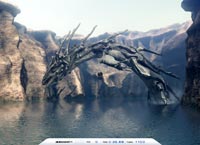 A Jules Verne type airship flies through a canyon guarded
by a dangerous sea monster. The airmen defend their ship using heavy cannons,
but these seem to have no effect on the huge sea monster. Finally the crew
manages a narrow escape using the "last resort" afterburners of
the airship.
A Jules Verne type airship flies through a canyon guarded
by a dangerous sea monster. The airmen defend their ship using heavy cannons,
but these seem to have no effect on the huge sea monster. Finally the crew
manages a narrow escape using the "last resort" afterburners of
the airship.
This scene is fairly complex with large areas of water
reflecting the high canyon walls. The water actually is one of the key points
of interest in this scene. The water not only does realistic looking reflections
and refractions, it has a depth fog, making the sea monster swimming under
the airship actually look deep down in the water. The air in this scene also
uses a volumetric fog, making distant cliffs of the canyon really look far
away.

In some games, 3DMark05 seems to work better with the Dual GPU card than with two cards. The Extreme N7800GT card has an advantage over SLI cards. The memory works better (faster) with the Dual GPU card, because in the case of SLI, memory has to be synchronized through the mainboard, and this might cause some delays in performance, especially from mainboard to mainboard. The end result is that the throughput is not as high.
Final Score
3DMarks on 3DMark05 are now calculated by the following formula:
(Game Test 1 * Game Test 2 * Game Test 3)^0.33 * 250
This is basically the geometric mean of the total frames in each
game multiplied by 250. This means that all game tests are now equal.

The Dual-Core concept gets really close to SLI performance. The total score of 11348 is high enough when we considering that this is the score of dual 7800GT GPUs, while two 7800GTX GPUs in SLI could only get about 100 3dMarks more.
6. 3DMark2003
 3D Mark is a widely used and accepted benchmark that stresses the DirectX performance of a VGA card. A very strong point of 3DMark is that it's VGA card measuring is does not require any CPU power. So the resulting fps are a good reference a VGA card's rendering performance. For testing the performance of each card we used the 4 game benchmarks 3DMark has.
3D Mark is a widely used and accepted benchmark that stresses the DirectX performance of a VGA card. A very strong point of 3DMark is that it's VGA card measuring is does not require any CPU power. So the resulting fps are a good reference a VGA card's rendering performance. For testing the performance of each card we used the 4 game benchmarks 3DMark has.
3Dmark03 also includes sound and CPU tests as well as some other feature tests.
- Game Test 1 - Wings of Fury (DX7)

This test is a combat flight simulator written for older hardware (DirectX 7). Particles are used a lot in this test - smoke and vapor trails, flak and gunfire, and explosions are produced using point sprites and quads.
- Game Test 2 - Battle of Proxycon (DX8)

This test is a simulation of first person shooter game types. 1.1 and 1.4 Vertex shaders are widely used since all character models are skinned using vertex shaders.This makes this test a good vertex shader comparison for VGA cards.
- Game Test 3 - Trolls' Lair (DX8)

This test should be the favorite of all RPG lovers. It is a cut scene of a female warrior facing two malicious trolls. Again the same vertex and pixel processing is used as in game test 2.
This test also uses post-processing effects, such as Depth of Field and Bloom effects which are widely used in today's game cut scene sequences.
- Game Test 4 - Mother Nature (DX9)

Mother nature represents the level of effects and realism that are possible using 2.0 vertex and pixel shaders, plus some other features that DirectX 9 offers.

Again, the 3dMark03, like the newest 3dMark05 software, seems to prefer a single Dual GPU card than two cards in SLI mode. This might be because of the memory synchronization effect that we mentioned before.
- 3DMark Official score
If you test your machine with 3DMark, you can post the results at 3DMark's online result browser. For more information visit futuremark.com.

Now, we have seen it all. Is it possible that 7800GT GPUs are faster than 7800GTX GPUs? According to the graph above, they can be, when they are on ASUS' graphics board.
7. Codecreatures
 CodeCreatures is a synthetic 3D benchmark that is a good reference for VGA performance comparison. This is a high-end 3D benchmark that also requires DirectX 8 hardware, making a good tool for measuring the potential of DirectX 8 game performance.
CodeCreatures is a synthetic 3D benchmark that is a good reference for VGA performance comparison. This is a high-end 3D benchmark that also requires DirectX 8 hardware, making a good tool for measuring the potential of DirectX 8 game performance.
The Codecreatures benchmark is written with Microsoft's DirectX 8.1 API and incorporates the use of Vertex and PixelShaders popular on next generation 3D accelerators.

The benchmark plays a photo-realistic nature scene and calculates the performance of the graphics adapter by measuring the fps that it can display at 1024x768, 1280x1024 and 1600x1200 resolutions.

-Codecreatures number
The codecreatures number is the resulting score of the total
benchmarking process and is basically the geometric mean of the three frame
rates multiplied by 100.

Again, the N7800GT Dual gave us some very good results. However, at low resolutions, the N7800GTX TOP managed to surpass all the other cards in this comparison.
8. Aquamark - 3DMark01
 Since the majority of today's applications and games are compatible with DirectX 9, the need of benchmark applications that use DX 9 has been brought up. The benchmark uses the 3D engine (Krass engine) of the Aquanox game.
Since the majority of today's applications and games are compatible with DirectX 9, the need of benchmark applications that use DX 9 has been brought up. The benchmark uses the 3D engine (Krass engine) of the Aquanox game.
Aquamark Triscore
The Aquamark Triscore comprises 3 values: the overall system performance, the performance of the graphics system and the CPU performance. Keep in mind that this is not the total result of the tests, but the result of the whole benchmark process including all 9 chapters.

Although the N7800GT DUAL gets close to the 7800GTX SLI board, it doesn't quite reach it. Certainly though, the Dual 7800GT GPUs perform better than two 7800GT GPUs in SLI.
3DMark 2001
 is the predecessor to 3DMark03. It's mainly a directx8.1 benchmark and the score depends a lot on the CPU power of your computer. However for reference use only we decided it'd be best to just leave it in our benchmark list so you can compare the next generation cards with the possibly outdated you have at home.
is the predecessor to 3DMark03. It's mainly a directx8.1 benchmark and the score depends a lot on the CPU power of your computer. However for reference use only we decided it'd be best to just leave it in our benchmark list so you can compare the next generation cards with the possibly outdated you have at home.

Although 3dMark01 is considered outdated, it too reported similar results to all the previous tests.
9. Half Life 2

Half life 2 is no doubt the most anticipated pc game of all times.
 Characters - Advanced facial animation system delivers the most sophisticated in-game characters ever seen. With 40 distinct facial "muscles," human characters convey the full array of human emotion, and respond to the player with fluidity and intelligence.
Characters - Advanced facial animation system delivers the most sophisticated in-game characters ever seen. With 40 distinct facial "muscles," human characters convey the full array of human emotion, and respond to the player with fluidity and intelligence.
Physics - From pebbles to water to 2-ton trucks respond as expected, as they obey the laws of mass, friction, gravity, and buoyancy.
 Graphics
- Source's shader-based renderer, like the one used at Pixar to create movies
such as Toy Story® and Monster's, Inc.®, creates the most beautiful
and realistic environments ever seen in a video game.
Graphics
- Source's shader-based renderer, like the one used at Pixar to create movies
such as Toy Story® and Monster's, Inc.®, creates the most beautiful
and realistic environments ever seen in a video game.
AI - Neither friends nor enemies charge blindly into the fray. They can assess threats, navigate tricky terrain, and fashion weapons from whatever is at hand.
To measure performance we used the Video Stress Test(VST) that is available in the CounterStrike:Source beta available through Steam. We set all the details to the highest level and each time changed the resolution from 800x600 up to 1600x1200.

Remember the memory throughput issue, where SLI cards must synchronize any transfers through the mainboard? Here it is again. The N7800GT Dual performed better than all other cards, and at some resolutions almost 30fps higher.
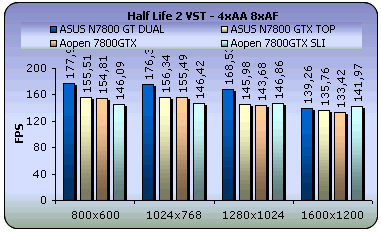
On the other hand, with AA and AF enabled, only at 1600x1200 screen resolution was the card slower than the 7800GTX SLI. At all other resolutions, with AA and AF enabled, the Dual GPU card was in front with a difference.
10. Doom 3

A massive demonic invasion has overwhelmed the Union Aerospace Corporations? (UAC) Mars Research Facility leaving only chaos and horror in its wake. As one of the few survivors, you struggle with shock and fear as you fight your way to Hell and back, in an epic clash against pure evil.
Activision made it's miracle again with Doom 3 which is said to be the best-looking game ever, thanks to the brand-new OpenGL graphics engine used to generate its convincingly lifelike, densely atmospheric, and surprisingly expansive environments. If you are a fan of the previous Doom games then you will get many flashbacks with this revision, since you will find reimagined versions of almost every monster from both Doom and Doom II.

To measure performance on the game we used the timedemo demo1 command from the console (Alt+Ctrl+~).
Enabling the high quality setting and executing the timedemo demo1 command twice for each resolution, we witnessed the following:
First, without the Anti-Aliasing and Anisotropic Filtering settings
enabled, we get the following results:

110.1 fps is the highest frames per second that the Doom3 engine can offer in the timedemo. This means that even if we could hypothetically create a card 10 times faster than the fastest card, we would again get 110.1fps. It is interesting, though, that at 1600x1200, the N7800GT Dual produced the most frames. The 512MB of RAM seems to be doing a good job with Doom3.

All advanced features enabled and the scene remains the same.
11. Far Cry

 You are Jack Carver running your own boat charter business in beautiful Micronesia. With a past best left behind you, you'll be focusing on your present assignment: escorting an ambitious journalist named Valerie Cortez to the Island of Cabatu. It seems like a piece of cake, but you'll soon learn: paradise can be hell.
You are Jack Carver running your own boat charter business in beautiful Micronesia. With a past best left behind you, you'll be focusing on your present assignment: escorting an ambitious journalist named Valerie Cortez to the Island of Cabatu. It seems like a piece of cake, but you'll soon learn: paradise can be hell.
Farcry is an awesome First Person Shooter (FPS) based on a last generation 3D engine named as CryEngine. Real-time editing, bump-mapping, static lights, network system, integrated physics system, shaders, shadows and a dynamic music system are just some of the state of-the-art features that the CryEngine offers.
A great advantage and strong point of the CryEngine is its physics system which supports character inverse kinematics, vehicles, rigid bodies, liquid, rag doll, cloth and body effects. All physics seem to be very realistic and you never get bored when facing enemies, since character models have multiple animations that blend in believable ways.
With an integrated shader system and a massive terrain which maximizes
the view distance to 2km, these features make Farcry a perfect action game and
also a referable benchmark to speak of.
- Benchmark Settings
For this game we recorded a custom demo from the start of the Rebellion
stage. We chose an indoor scene in order to avoid getting the CPU bound effect. This will result in slightly higher results since it is also less
GPU intensive, but we can't afford being stuck at 40-50 fps because of our CPU.

The latest patch (1.3) was used for our tests which updates the
game's graphics engine to use the 3.0 Shader model. This option is only supported
for the 6800 series.

The resolutions we ran the demo under, are the following:1024x768,
1280x1024 and 1600x1200.

With FarCry, the ASUS N7800GT DUAL again lagged only slightly behind the 7800GTX SLI card.

Nothing changes with AA and AF enabled.
12. Thief 3
 Instead
of Deus Ex from now on we'll be testing our cards using Thief 3. It's based
on the same engine but it's much less GPU intensive and playable by more VGA
cards than
Instead
of Deus Ex from now on we'll be testing our cards using Thief 3. It's based
on the same engine but it's much less GPU intensive and playable by more VGA
cards than  Deus.
Deus.
The game makes severe use of Pixel Shader 1.1 instructions, the bloom effect and stencil shadows to achieve a wonderful result in your screen.
In the game you play the part of Master Thief Garrett who is back to rule out any evil forces using his unique stealth abilities. Deadly Shadows shows what stealth gameplay is all about. This game really gives you the feel of sneaking around and holding your breath when stuck in a sticky situation.
Since there is no official benchmark for the game, we'll do our tests using
a GPU intensive scene from the tutorial-level which we believe that represents
the average fps you'll get when playing the game.
Thief 3 is a torture test for graphics cards. All lower class cards fail to provide stable performance in this benchmark when selecting full details from the settings menu.

At low screen resolutions, the fps we got were more or less expected. On the other hand, looking at the fps for 1600x1200 screen resolution, the DUAL GPU card was the best performing card. The Thief3 gaming engine prefers two GPUs on the same PCB rather than two cards in SLI mode. This also happened in some 3dMark games.

Again, at low resolution, everything seems to be normal, with the N7800GT Dual being slightly slower than the two 7800GTX SLI and faster than the single GPU cards. However, at high resolution, the Thief3 engine shows its preference.
13. Colin McRae 2005
 For all you racing fans out there, this test is for you and will represent the Racing game category in our benchmarks.
For all you racing fans out there, this test is for you and will represent the Racing game category in our benchmarks.
From the graphics point of view the first thing you'll
notice in the game is the excellent amount detail of your racing car. High
resolution textures on the car and lighting make it quite impressive. All
the eye candy such as the sun reflection in the virtual camera are still the
same as the older CM versions but motion blur has been added when your card
hits something hard which will happen most often if you're new to the racing
simulation world.

To measure performance on the game we used fraps to get the average fps of the whole 8th stage of UK which is actually the only stage you get to play on the demo.


Nothing strange with Colin McRae 2005. Only at the screen resolution of 800x600 and with AA and AF disabled, could the N7800GT Dual outperform the 7800GTX SLI system, but as screen resolutions and graphics demands rise, the 7800GTX SLI takes control.
14. Ground Control II
 Ground
Control 2 is an action-oriented game of tactics and warfare. As Captain Jacob
Angelus of the Northern Star Alliance, you will command squads of infantry,
artillery, and air power against the might of the Empire of Terra. Base building
and resource-collecting are replaced with unit control and combat tactics where
your knowledge of the battlefield maneuvers will make the difference in your
fight against a ruthless enemy. Position your troops on hilltops for better
aim or inside buildings and forests for protection as you'll need to use every
inch of terrain to your advantage.
Ground
Control 2 is an action-oriented game of tactics and warfare. As Captain Jacob
Angelus of the Northern Star Alliance, you will command squads of infantry,
artillery, and air power against the might of the Empire of Terra. Base building
and resource-collecting are replaced with unit control and combat tactics where
your knowledge of the battlefield maneuvers will make the difference in your
fight against a ruthless enemy. Position your troops on hilltops for better
aim or inside buildings and forests for protection as you'll need to use every
inch of terrain to your advantage.
For our benchmarks, we used the highest possible settings on the first mission
of the single player game and moved around the camera to get an average frame
rate using fraps.

Ground Control II offers really impressive graphics without requiring much GPU power. Click on the picture above to view a screenshot from the game. Check out these excellent water effects!

The increased core and memory frequencies of the ASUS 7800GTX TOP seems to really boost this card at 1600x1200, even higher than the DUAL GPU card. Apart from this, everything else is business as usual with all other resolutions.

The N7800GT Dual did not lose a lot in performance when AA and AF were enabled.

15. NFS Most Wanted
 Wake up to the smell of burnt rubber as the thrill of illicit street racing permeates into the air.
Wake up to the smell of burnt rubber as the thrill of illicit street racing permeates into the air.
Combining illicit street racing and tuner customization with the intensity of strategic police pursuit that surpasses any Hollywood-style chase scene, Need for Speed Most Wanted will be on every gamer's 'must-have' list this holiday season. Out-race rivals, evade cops and exploit hundreds of miles of open road as gamers make their way up the Blacklist.
To become the most wanted racer, players must build up their street cred and Rap Sheet with gripping, white knuckle, head-to-head races with the top drivers on the streets, as well as pull daring, evasive moves to out-run and out-fox the cops that patrol the open road. Players can manage their heat or utilize a number of strategic tactics to keep the cops off their tails as they leave their rivals behind to suck their exhaust fumes.

- Benchmark Settings
NFS Most Wanted does not include a default benchmark. To measure the card's performance, we've chosen to record the framerate at the start of a circuit race with end-game cars. The starting point tends to be one of the most graphically demanding sections because of the smoke created by spinning wheels added to the rest of the game's visual effects. If a card can pass this stage with an acceptable framerate, it is a guarantee that it will face no problems with the rest of the game.

The resolutions we used are 800x600, 1024x768, 1280x1024 and 1600x1200. We measured performance at the lowest and highest possible settings.

All cards in this comparison show similar performance. Only at 1600X1200 does the AOpen 7800GTX fall behind. The ASUS N7800GT Dual GPU card reported the exact same framerate as the 7800GTX SLI. This is again because of the memory throughput we've mentioned before.

Similar story with highest settings, but with lower framerates obviously.

16. F.E.A.R.
 You aren't a soldier. You are a weapon. A paramilitary force infiltrates a multi billion dollar aerospace compound taking hostages, but issuing no demands.
You aren't a soldier. You are a weapon. A paramilitary force infiltrates a multi billion dollar aerospace compound taking hostages, but issuing no demands.
The government responds by sending in its best special operations teams, only to have them obliterated. Live footage of the massacre is cut short by an unexpected wave of destruction that leaves military leaders stunned and in disbelief.
First Encounter Assault Recon (F.E.A.R.) is one of the new-generation FPS. The graphics are really stunning, the plot behind the whole shooting successfully keeps it interesting and even the A.I. seems to work well.
F.E.A.R. offers a lot to the First Person Shooter world. The graphics are very clear with excellent textures, great new effects that will stress your graphics card and rag-doll physics that are waiting to be exploited as you progress through the game.
- Benchmark Settings
F.E.A.R. allows you test the video settings with a mini-benchmark involving a lot of weapon firing, explosions and several other effects. After the benchmark is run, you're presented with a screen showing your minimum, average and maximum framerates and also percentages of how often the framerate was below 25fps, between 25 and 40, and finally above 40. For presentation reasons, we're just sticking to the minimum and average framerates.

The resolutions we used were 800x600, 1024x768, 1280x1024 and 1600x1200. We measured performance at high and highest details.



As with NFS: Most Wanted, the Asus N7800GT Dual and 7800GTX SLI had similar performance.

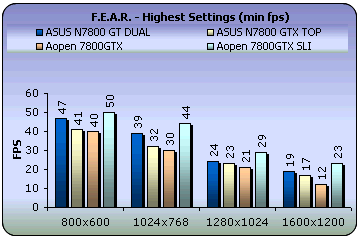

At Highest Settings, we see that all cards find it tough going, especially at the higher resolutions.

17. Quake 4
 In a desperate war for Earth's survival, against an unrelenting alien enemy, the only way to defeat them is to become one of them. Armed with advanced weaponry and vehicles and aided by an elite squad of marines, you take the battle to the heart of the Strogg home planet and become Earth's only hope for victory.
In a desperate war for Earth's survival, against an unrelenting alien enemy, the only way to defeat them is to become one of them. Armed with advanced weaponry and vehicles and aided by an elite squad of marines, you take the battle to the heart of the Strogg home planet and become Earth's only hope for victory.
Quake 4 is a First Person Shooter developed by Ravensoft, based on the Doom 3 engine, and the graphics and gameplay certainly reflect that fact. For those who really hated the one-way corridors of Doom 3, new outdoor areas have been added to the game. The feeling however, still remains the same as these areas are quite small-scale, contrary to what other games have to offer.
- Benchmark Settings

As Quake 4 includes no default benchmark, we decided to go with another publicly available demo to measure performance. What we chose is a demo from HWSpirit, which involves a small outdoor scene followed by a long indoor combat. As preloading the stage once again failed miserably and the average framerate varied a lot, the second time we ran the demo, we ran it twice every time we restarted the game and measured only the second run.

The resolutions we used are 800x600, 1024x768, 1280x1024 and 1600x1200. We measured performance with and without Anti-aliasing.

Since Quake4 uses the Doom3 gaming engine, we did not expect big changes with this game, and we were not wrong.

With AA and AF enabled, nothing really changes (there's only a few fps difference from AA and AF disabled), until we reach 1280x1024 where the frame rate drops considerably, but the difference between the cards remains fairly constant. That is, at 1600x1200, the difference for all cards is around 25 fps for AA and AF disabled and enabled.

18. Overclocking
No matter your graphics card, there comes a time in your
computer's life when it can no longer cope with the latest technological
demands the ever so popular games impose. This is one of the main
reasons for overclocking your graphics card. Gamers are always looking forward
to
a
little extra
boost in terms of framerate. Even though most of the times the boost is far
from noticeable, overclocking remains the last resort when you can't afford
to buy a brand new VGA card.
The default core and memory clock are set to 4300MHz and 1.2GHz respectively. To be honest, we did not expect much from the Dual GPU card. Older Dual GPU card attempts showed how bad overclockers they were because of engineering problems. Another concern is temperature, although we think that temperature has less to do with the disability to overclock in this case.

Unfortunately, we could only manage a gain of 30MHz core clock frequency. The memory clock could not be changed at all without producing the blue screen of death and artifacts in Windows XP. However, 30MHz gain is not small in a Dual GPU card.

Overclocked, the card gave us 46°C when idle and 61°C maximum during intense gaming, which is great considering the 69°C we got with the 7800GTX single GPU cards.


Let's see how much of a difference we gained in performance.
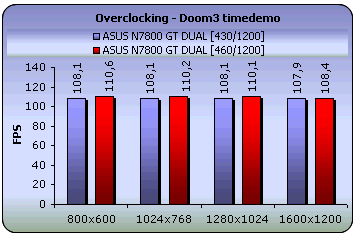


Since the card proved a weak overclocker, the difference of 3 fps is not worth the risk and we would suggest leaving it at its default settings.




19. Conclusion
 This was the first Dual GPU card we have received from ASUS and we were quite impressed first of all by the look of this card. This is a Limited Edition card with the series number engraved on the heatsink to signify how its limited supply.
This was the first Dual GPU card we have received from ASUS and we were quite impressed first of all by the look of this card. This is a Limited Edition card with the series number engraved on the heatsink to signify how its limited supply.
The package is very complete, as with most ASUS VGA cards. You will really find everything that you will need in the retail package. If you don't have a hefty PSU, don't forget to order the optional AC adapter.
The card is really huge, and if you are interested in buying it, size isn't going to be your only concern. The ASUS N7800GT Dual VGA card is not compatible with all PCI-E motherboards. You can see a list of compatible motherboards presented earlier in this review, but most compatible motherboards are from ASUS.

In performance, the N7800GT Dual GPU card performs similarly to the 7800GT SLI system. Getting one card and not two SLI cards has some major advantages. First of all, you gain some space in your case layout. Secondly, we noticed increased performance in some cases, due to the single PCB handling video memory synchronization rather than it going through the mainboard bus with intervening SLI circuitry. And if you want your PC system to produce less noise, the ASUS N7800GT Dual uses only one fan, while two 7800GT cards use two fans (one fan for each card).

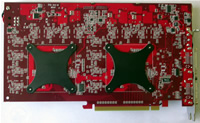
Overclocking is the weak point of this card. We managed to get only 30MHz core frequency gain, and in most benchmarks, the performance did not increase by more than 3 fps. But then, we shouldn't except everything from this type of card when it comes to overclocking. On the plus side, the temperature was kept at low levels when overclocked.

Because this card comes in Limited edition only, it might not be that easy to find on the market. The card is priced a little above US$800, a reasonable price considering the cost of two 7800GT cards. This is indeed the fastest card available on the market today. We would certainly prefer to have the Limited edition Dual GPU card rather than two cards in our case.
Pros:
- Best performing single card available
- Excellent cooling system
- SLI in one PCB
- Considerably low noise levels
- Great ASUS and nVidia features
- Limited Edition card
Cons:
- Not compatible with all mainboards
- Limited overclocking
| Performance: |
 |
| Overclocking: |
 |
| Bundle: |
 |
| Value for money: |
 |
